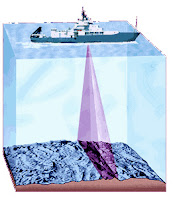January 9 marked Jason’s first dive of the expedition. The vehicle descended to 2300 meters to reach our first target, the Von Damm vent site, which is the shallower of the two planned locations. Shortly after reaching the seafloor, the vehicle began heading towards the vents.
 |
| Tubeworm goes under the microscope |
Along the way, the science team instructed the pilot to collect samples of interest. With its two strong robotic arms, Jason was able to break off and collect several samples of rock and pieces of the vent. Jason’s arms are also dexterous enough that they gently collected five tubeworms, a clam, and a sea cucumber and placed them in a tub on the front of the vehicle called the bio box.
Because this site is so unique, energy levels in the ROV van were high. After Jason surfaced, the science team quickly retrieved their samples and began analyzing them. It was an incredible experience to be present as Jason returned with samples from the Mid-Cayman rise, home to the deepest hydrothermal vents ever discovered.
Dive #2 Underway
 |
| Jason dives to Piccard |
The images from Piccard were breathtaking, with black smokers sending a whirlwind of mineral-rich fluid into the dark water. Everyone in the van was mesmerized by the images on the monitors, even if they had seen hydrothermal vents many times before.
 |
| Microbial mats |
During the dive, we saw strange yelloworange and white mats—what looked like fur on rocks was actually strings of microbes! Jason also broke off a piece of the vent to bring up to the surface at around midnight tonight.
History of the Cayman Rise
I was curious as to why this particular site is of such scientific interest, so I sat down for an interview with Dr. Chris German, the PI (Principle Investigator) of this expedition. He filled me in on the history of exploration of the Cayman Rise and why he is so interested in studying it.
In 1976, Bob Ballard, a geologist then working at Woods Hole Oceanographic Institution, became the first person to investigate the seafloor at the Mid-Cayman Rise. The vents had not yet been discovered, and he used Alvin, the famous submersible, to explore the area. However, this ridge reaches depths of 5000 meters or more and Alvin can only reach a depth of 4500 meters. Ballard’s team also brought along Trieste, a bathyscaphe capable of diving to greater depths, which they used to reach deeper parts of the ridge. “This was the only time that anyone has been down there and seen it with their own eyes” Chris said.
However, because Trieste could only go up and down, they had to tow a camera system called ARGO over the seafloor to get the first confirmation that there were lava flows down there. “Thirty-five years later we get the first chance to come back with the latest WHOI technology and study cool new vents that were probably actively here all along.” Chris said.
 |
| Seafloor spreading (USGS) |
 | |
| Multibeam bathymetry |
When Trieste descended on the site, the scientists inside took photographs, but their ability to explore was limited, as Trieste couldn’t move around like Alvin or Jason. Despite this minimal data, the scientific team knew there was volcanic basalt in the deep parts of this ridge, confirming suspicions that, indeed, the Cayman Rise was a spreading center.
Want to find out why this particular site is so important to study? Stay tuned!







No comments:
Post a Comment